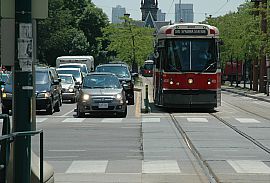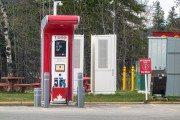This week, CBC’s Here and Now is running a series that explores how commuters can ease the pain of getting around greater Toronto.
In today’s episode, I ride the streetcar, bus and subway with producer Jason Osler and discuss interim solutions for commuters until better transit is built. There’s only so much you can fit in a radio segment, so I wanted to unpack some of those ideas. But first, let’s start with some background.
Short-term gain for long-term transit
The provincial government is currently considering how to pay for the Big Move transit plan. Metrolinx has provided them with an investment strategy that recommends a suite of revenue tools, which will cost the average household about $477 per year.
That really is a small cost to pay for a modern network of rapid transit that will reach 80 per cent of people in the Greater Toronto and Hamilton Area. Every other major city in North America has bitten the bullet and raised taxes to build rapid transit and remain economically competitive. Here in Toronto, we have a lot of catching up to do.
For a region that’s trapped in gridlock or crammed into subways and streetcars, new taxes for tomorrow’s transit are a tough sell. There’s also the collective cynicism entrenched by a century of promised transit lines that were never built. However, the province, municipalities and transit authorities can take some immediate steps to sweeten the deal.
Below are seven actions that can help build public support around the need to fund transit expansion, while also offering benefits to the tax-paying commuter in the meanwhile.
1. Better service now
The introduction of all-day GO train service on the Lakeshore line, with a train every 30 minutes at a minimum, is an example of an immediate improvement in service on critical and crowded routes. It’s also a good strategy for underserviced routes. Instead of cutting service to save money, transit authorities should be aiming to grow ridership.
Everyone wants to get people moving faster throughout the region. That isn’t going to happen by adding more cars to the roads, but rather by getting more commuters using transit or other modes. Twenty-five percent of Big Move funding is allocated to municipalities for local projects. A portion of those funds could be used immediately to improve service today.
2. Commuting to the den
Instead of travelling to an office, some workers can telecommute by staying home and communicating with their colleagues online. A Tokyo study in 2010 found that telecommuting could reduce traffic congestion by more than 10 per cent. It also produces economic benefits for everyone — not just telecommuters — that are equivalent to about one quarter of the average household’s transportation expenditures.
Telecommuting in the GTHA has a lot of potential. The most suitable jobs for telecommuting are office jobs which, according to 2010 employment survey numbers, account for about 50 per cent of workers in Toronto.
3. Cash for not parking
A growing number of U.S. cities and states are adopting the parking cash-out system for commuters whose parking is paid for by their employer. In a cash-out system, the employer pays a cash incentive to employees who leave their cars at home and find another way to commute. Often, the incentive is equivalent to what the employer would have paid for a parking spot.
Parking cash-out in California has reduced car trips by 11 per cent. It has also been introduced in Madison, Wis. and Washington, D.C.
4. Pay only when you drive
The Ontario government has promised to reduce auto insurance premiums by 15 percent — a golden opportunity to introduce pay-as-you-drive (PAYD) insurance and reduce congestion. In the United States, PAYD insurance exists in 39 states and has reduced premiums by 10 to 15 per cent, while reducing the number of cars on the road by 10 per cent.
 The logic is simple: if you pay a lump sum for insurance, you’re less likely to also pay for transit tickets. But paying only when you drive frees up room in your personal budget to make other choices, like taking transit a few times a week, or using the car to get to the cottage on weekends, while investing in a bike or a transit pass during the week.
The logic is simple: if you pay a lump sum for insurance, you’re less likely to also pay for transit tickets. But paying only when you drive frees up room in your personal budget to make other choices, like taking transit a few times a week, or using the car to get to the cottage on weekends, while investing in a bike or a transit pass during the week.
In a survey conducted by the Pembina Institute in 2010, two-thirds of GTA drivers said they would likely try PAYD insurance. Of those drivers, 85 per cent would find another way to get to work if they had PAYD, with 70 per cent would take rapid transit.
5. Tax breaks
Smart Commute is an excellent program that encourages commuters to shift to other modes of transport. However, some sweeter options could help take the edge off of revenue tools until rapid transit makes it to car-dependent suburbs.
This includes actual financial incentives, such as tax breaks similar to transit credits, or government-supported employer benefits for carpooling, mode-shifting, flex hours or telecommuting.
6. Thinking inside the lines
As Jason and I rode the streetcar, we talked about the advantages of providing a right-of-way for either the Queen or King streetcar lines, as was proposed by the Toronto Transit Commission this summer.
There is no rapid transit running east-to-west across downtown Toronto, to the south of Bloor Street. The Big Move includes a downtown relief subway line, which is greatly needed, but it won’t be built for several years. A streetcar right-of-way could provide that relief for commuters in the meanwhile.

The key infrastructure — tracks and streetcars — is already in place. Other cities in North America are scrambling to install new streetcars on streets to not only move people, but also to generate the lively and economically-fertile downtown streetscapes that derive from streetcar transit.
Critics who suggest that streetcars are in the way of cars have it backwards: it’s the one car with a single passenger that blocks 130 streetcar passengers (or 250 on the new vehicles).
The current mess of mixed traffic on Queen and King isn’t helping anyone — drivers, transit riders, cyclists or merchants. Dedicating streets to transit and bicycles consistently results in better traffic flow, while dedicating streets to cars just brings more cars and more congestion, as is evident on Adelaide Street and Richmond Street.
7. Show us the money
Recently, the transit funding debate has focused on how best to generate revenue for the Big Move from tools like a sales tax, gas tax or parking levy. But we also need to consider how quickly and effectively the transit projects can be financed.
Some municipal politicians fail to grasp the difference between funding and financing, and think private investment is free. Financing is private investment to cover the up-front capital costs of building transit infrastructure. Funding, in the form of guaranteed revenue streams, is required to pay back these loans.
The transit fare box rarely covers operating costs, let alone the extra cash needed to pay for new infrastructure. That’s why we need new revenue tools — attracting private financing for transit infrastructure requires the guarantee of revenue streams, and the capacity of government to pay back loans.
The ongoing flip-flop over light rail transit versus subways, along with opposition to the idea of revenue tools, sends signals of uncertainty to the investment community. That, in turn, delays shovels going into the ground. Toronto needs to get its act together to attract the type of financing that won’t saddle us with high borrowing rates and extreme debt.
Los Angeles accelerated a 30-year transit build to just 10 years by backstopping a loan with the revenue from a one per cent sales tax dedicated to transit. Cities in the U.S. such as Atlanta and Dallas are securing low borrowing costs through Build America Bonds. Denver is speeding up the process with pledged revenue from sales taxes.
A mobility charter for the GTHA
The ideas above are just a few ways to provide immediate relief for commuters, as a form of quid-pro-quo for the higher taxes needed to address our decades-long transit deficit.
Ideally, a suite of options such as these could be packaged into a “mobility charter” that includes the province’s commitment to a dedicated transit fund, as well as Metrolinx’s proposed mobility tax credit to address equity concerns. It’s a way of giving something back to commuters now, while we wait for the promise of a better transportation network in the future.
Follow Cherise on Twitter @CheriseBurda.






